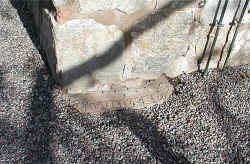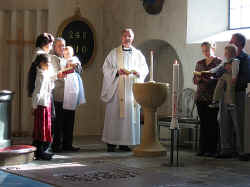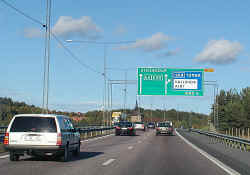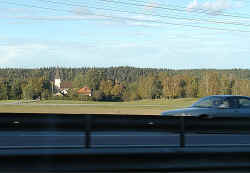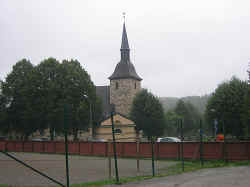
Saint Botvid who gave name for the municipality of Botkyrka in the southern parts of Stockholm county, is one of only two guardian saints of the province or landscape of Södermanland (Sörmland) on the southern shore of lake Mälaren and bordering the Baltic Sea in the east and southeast. Together with Saint Eskil who gave name for the city of Eskilstuna a hundred kilometres to the west, Saint Botvid lived in this area sometimes between 1050-1120.
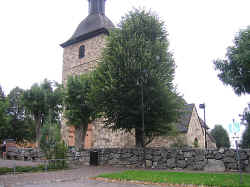
As an adult Botvid went for a journey to England where he was lodged by an unusually devoted and wise priest that taught him about Christianity.
Botvid was baptised in England and stayed another six months before returning to his native district.
By good example and useful admonitions he tried to convert the heathens at home to christianity.
Despite bad conditions two boats became fully loaded with fish after only one catch.
Botvid bought a Slavic thrall or slave which was tought about Christianity and baptist. On the boat journey across the Baltic
Sea, towards Finland to release the baptised thrall they stayed
over night on the island Rogön. While Botvid were asleep the
thrall took Botvid's own axe and murdered both Botvid and another
fellow-traveller and dissappeared with the boat out of history.
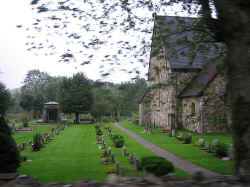
During this period an incredible amount of miracles began to occur at the grave.
At the same time Botvid's brother Björn began building a wood church beside their father's Hammarby farm and called it Botvidia Kirkia.

I wonder why Botvid took a detour to the island Rogön on his
way to Finland?
I need two days only for the detour with my own boat today!
Maybe he wasn't on his way to Finland at all?
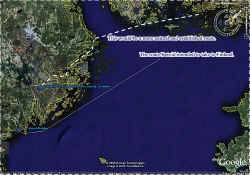
A placemark at Rågön for Google Earth users.
There are voices claiming that the murder could have happened already in the year 1080, but then I can't figure out how Björn could have build the church and to me the whole story is overturned. So I'll stick to the first version.
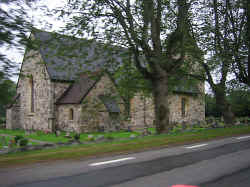
In the medieval tradition, a well would always be found in connection to the death of a saint.
When the remains of Saint Botvid were carried from Säby Church (today's
Salem Church) in procession led by
the Bishops of Uppsala and Strängnäs to the new wood church Botvidia
Kirkia, the casket was temporarily put down
for the men to rest near the shore of Bornsjön.
While the men were
resting a well poured
up!
I have been told the well is even today providing clear water at the rate of 5-10 liters per minute, and have finally found it myself.
At a
bus stop there was a small wood sign that said
"Källa" (well).
Then it was only 50 feet to walk.
The ground was wet all around the well. It seems
to pour up water everywhere, but in the man maid
pit the water looks like pickled herring stock,
slowly moving around. The growing sea weed in the
well clearly shows that it never freezes during
winter. The well pours up just half a foot higher
than the Bornsjön water level itself.
We leave the church for the well at the shore
of Bornsjön ...
The lake Bornsjön is protected by law as fresh water reserve for Stockholm city, and no human activities around or in the lake are allowed.
Measures have been taken by the authorities to prevent contaminated water from the expressway nearby to reach the well, pond, and lake Bornsjön.
Lake Mälaren is normally providing fresh water to the capital and
its surrounding municipalities.
Bornsjön is the reserve in case something should go terribly wrong with Mälaren, because there are all human activities allowed! :-)
The well!
Very close to the road with the bus stop.
The bus stop sign and my car at the opposite side of
the road are visable through the branches.
The bus stop with a wood sign down to the left.
This is one of the oldest roads of importance in
the country.
Probably used long before the Battle of Hastings.
The old "Riksettan" Realm Road One, and
prior to that called Göta Landsväg (Göta
Country Road).
Look close!
The water contains much minerals, maybe that's why
it grows so well in it.
The well is running directly out in the lake
Bornsjön.
Salem Church and the Rectory across the lake.
This was a short detour, and now back to the
church ...
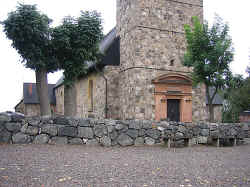
The bell tower was not finished until the very end of the 12th century. Today's main entrance in the tower is an almost modern idea from 1763. The previous one was in the weapon house.
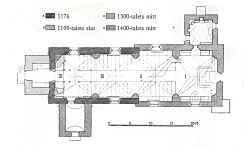
The first wood church was erected and innaugurated in 1128 or
1129. Replaced in 1176 by the stone
church shown in the plans above.
The darkest walls, the left half of the long house is
the oldest part of the stone church from 1176. The rest is extended during three
centuries.
The stone church was inaugurated by Sweden's first Archbishop Stefan of Uppsala and Bishop Vilhelm of Strängnäs in 1176.
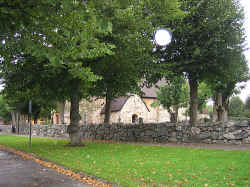
The weapon house, former main entrance to the church.
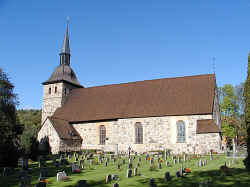
The church
bells!
The largest of the three bells with a weight of
about 550 kg were casted by
Medardus Gesus in Riga, Latvia, in 1620, and were
ordered for the Cathedral in Riga.
But the Swedish Army happened to pass by...
Today it would probably be considered a criminal act, a war crime,
and reported to and judged by the Haag Tribunal.
Botkyrka parish received the bell
from King Gustav II Adolf together
with an antependium and a chausable.
The middle bell was replaced (re-casted) in 1956, and the smallest bell in 1964. Both re-casted by Gösta Bergholtz in the town Sigtuna.
By the way, Don't we owe the Czech Republic for a silver bible too?
A runestone as a cornerstone in the tower! No
one have managed to figure out the whole story
told on the stone. :-)
The visible runes says: ... and Tove, they had
this stone erected after ...
There is another runestone in the floor
inside,
face down. No one knows what that one says either.
Two more stones have been found high up on the
outer walls.
Stolen church bells and silver bibles makes me think of something that doesn't have to do with the church, but more about giving things back to their owners ...
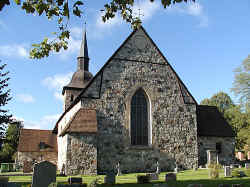
This is the largest window.
It is covered from the inside, behind the altar
piece. If I got it correct, to change the light
flow in the church and make it easier to view
the motifes and colours in the paintings in the
altar piece.
The contours of the window are still visible
inside behind the altar.
Chieftain G'psgolox's Totem Pole

Brought
to Sweden from Canada in
1929, this Haisla totem
pole has finally been
returned to Kitimat, B.C.
(Lars Epstein/Associated
Press)
Chieftain G'psgolox (pron. Gupsgolox) Totem Pole of the Haisla Indians in British Columbia is actually repatriated from the Museum of Ethnography in Stockholm in early 2006.
In return for the sacred totem pole the Haisla tribe has made a new one for the museum in Stockholm.
A placemark at Google Earth for the aluminium plant in Kitimat, with the village across the bay.
This is the new
G'psgolox's Totem Pole
made for
The
Museum of Ethnography
in Stockholm.
It has got a very good
place in front of the
museum, which also means
in the park and entrance
shared with both The
National Museum of
Science and Technology,
and The
Police Museum. The
old police helicopter, a
Bell Jetranger,
actually stands on its
own pole opposite to Chieftain
G'psgolox's
Totem Pole.
So close together, and
yet so far away!
Totem: The Return of the G'psgolox Pole
by
Gil Cardinal, National Film Board of Canada
You can watch this 70 minute long movie from the National Film Board of Canada, covering the poles history from 1872 till short before it really was repatriated in 2006!
It's a very
beautiful and educational
movie.
The length of 70 minutes
might seem too long, but you
can pause the film when ever
you need to.
Give it a try, you won't
regret it!
Totem: Return and Renewal
by
Gil Cardinal, National Film Board of Canada
Totem: Return and Renewal
Back to Botkyrka church again...
The pulpit in Gustavian style was donated by
the Councillor of the Realm Joakim von Düben in 1780 and
has his and his wifes Ulrika von Rosenheim
alliance coat of arms depicted on the
front.
The previous pulpit was dated 1518.
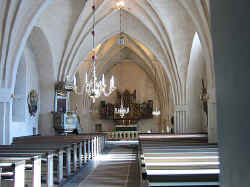
The interior and colours are from the complete renovation that was done in and around 1928.
The benches installed in 1903 replaced the benches that actually was inaugurated on Whitsunday in 1546, the very same day Martin Luther died.
I have previously said that the latest renovation was a
gentle one in 1977, aimed to be a fine tuning
of the renovation in 1928. But since the
organ was replaced,
the gallery extended,
the interior
repainted, I believe
the statement has to
be revaluated to be
a quite extensive
renovation instead.
I'm sorry it took me
so long to realize
this myself.
It's probably
because the interior
is so good looking,
and I thought it was
because people was
careful, that fooled
me! :-))
By the way, the carpet with the theme "Jacob's Ladder" in the longhouse alley, was created by Barbro Nilsson in 1977.
The medieval altarpiece is probably
the most valuable possession still placed
in Botkyrka Church.
It's from the time when Gustav Vasa was
crowned, and Sweden became a
sovereign state!
The altar depicts scenes of the history of
passion and the crusifixtion.
Jan
de Molder in
Antwerp in
Flanders created
the sculptural
parts of the
altarpiece around
1525. An anonymous
master of Antwerp
created the doors.
How and why the altar piece
came to Sweden and Botkyrka Church is
unknown, it may
even have been
purchased. ;-)
King Gustav I became so delighted of this
altar piece that he offered 300 dalers for
it, but the inhabitants in the
parish refused him!
Queen Katarina
Jagelonica however, managed to get it for
the Riddarholmskyrkan in Stockholm.
Her husband King Johan III
is said to have returned
it safely to Botkyrka
where it has been
ever since.
This organ housing was designed by
the architect Olof Tempelman in 1810 and
replaced the first instrument donated by
Lieutenant Bengt Ribbing at Hallunda
Farm in 1774. The present mechanism was
installed by Åkerman & Lund in 1977
and has 3 manuals and 36 pitches. Five
of them were
added in 1992 by
Nye organ
builders.
The company Lars
Norgren Åkerman
& Lund
Orgelbyggeri AB
as it actually
is called since
1974, was
founded in 1860
and is the
oldest organ
builder in
Sweden.
The old instrument was moved first to
Huddinge, the neighboring municipality
and parish, and later
moved to the island Gotland in the
Baltic Sea.
Listen to
this very organ and Botkyrka Church's own organist Rune
Karlsson playing,
Basse de
Trompette.
Festival
Finale.
In case you need RealPlayer click here!
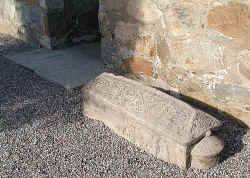
The Botkyrka Monument.
It is most likely a monument over
Saint Botvid's brother Björn, son
of Sven and Bänkfrid at Hammarby,
who built the first wood church.
This north window was designed by
Einar Forseth and originally placed in
the south wall. It was made as late as
1953.
The window depicts a scene of a part of
The Sermon on the Mount, Matthew
5-7.
Einar Forseth is perhaps best known for creating The Golden Hall consisting of 18 million golden tiles in Stockholm City Hall.
Worth
to mention is that most of the
invaluable artifacts in the church is
replaced by replicas such as the most
unusual so called The Botkyrka Monument
outside on the churchyard.
The church also has a complete alarm
system, with hidden cameras, connected
to a surveillance central.
Central heating with indoor climate control is installed since long, so there is no need for extra clothing even at early Christmas-morning services.
The
baptismal font in limestone was a gift
in 1904. It replaced a medieval font
that was spoken of as "old and
useless" already in 1702. Plans
to buy a new font were not realized
until 1787, and a simple tin font
purchased from Strängnäs is nowadays
stored in a closet somewhere. :-)
The picture is from September 2005
when our friends son Alexander were
baptised! An enchanting and memorable
event depicted in a slide show here!
Trinity.
On the south wall beside and above the
altar and baptismal font.
Nice to know, so to speak!
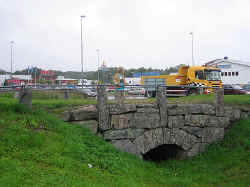
A remaining part of the Göta
Country
Road.
From the time before the Battle of Hastings.
In the middle of our shopping mall!
Our Henrik checks it
out, but the new Scania truck is interesting too!
The
stone
bridge
was
built
in
the
1890:s,
probably
to
leave
a
permanent
placemark
in
the
nature
since
the
importance
of
the
road
was
lost
since
long,
prior
to
this
it
was
made
of
wood.
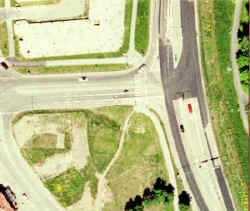
Göta Country Road Bridge
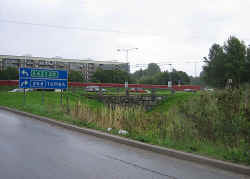
The main road through the Swedish realm, even before the realm got its name.
The area has probably been populated for at least 7,000 years! We have some knowledge, fragments, from the last 3,000! Tops!
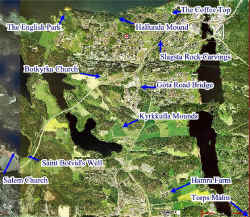
There are short stories about the places shown in the picture above at holmers.com
Finally, These are just a few
fragments out of almost a thousand
years of history.
The facts were found in
encyclopedias and in documents and
leaflets published by the Swedish
Church.
Some information found was so poor
that I may have coloured it a
little.
Some things I do just know, but I can't tell how
I got to know, or
why.
Consider this while reading!
Have fun and enjoy a part of our little
corner of the world!
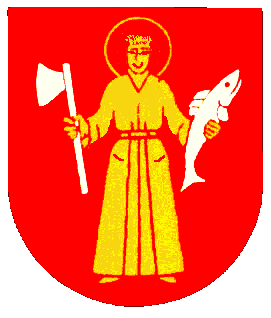
Botkyrka coat of arms.
I
don't think
I have
mentioned it
before.
But,
The Swedish
State Church
began as a
Roman
Catholic
Church and
was reformed
during, I
think, the
first half
of the 16th
century to
the Reformed
Lutheran
Church, and
as if this
wasn't
enough the
church was
separated
from the
Swedish
state as
late as
around the
turn of the
millennium.
Wonder what
reforms will
come next?
Well, Maybe
it
wasn't
a
reform
that the
previous Archbishop could
have been
succeeded by
his sister,
if she not
had been
beaten by
another
younger
brother,
that finally
lost in the
election to
a third non
related person!
But it
was
for
sure
fun
when it
happened
during
the Archbishop
election in
2006.
We live in a
small
country! :-)
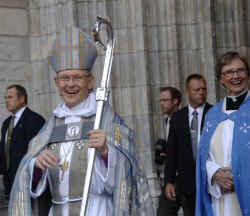
This
is
Sweden's
present
Archbishop
Anders
Wejryd
on
election
day
in
2006.
You can take a peek just to get an idea of where on earth you just have been!
Google Earth users will find a useful placemark here.
This is the first glimpse of Botkyrka Church a visitor to Stockholm will get arriving from south on the expressway E4/E20.
But
first, right after
the Salem exit
this view will
appear on the left
side. It's the
Salem Church on
the small cape in
the lake
Bornsjön.
A
360 degree
Panorama
of Salem
Church
